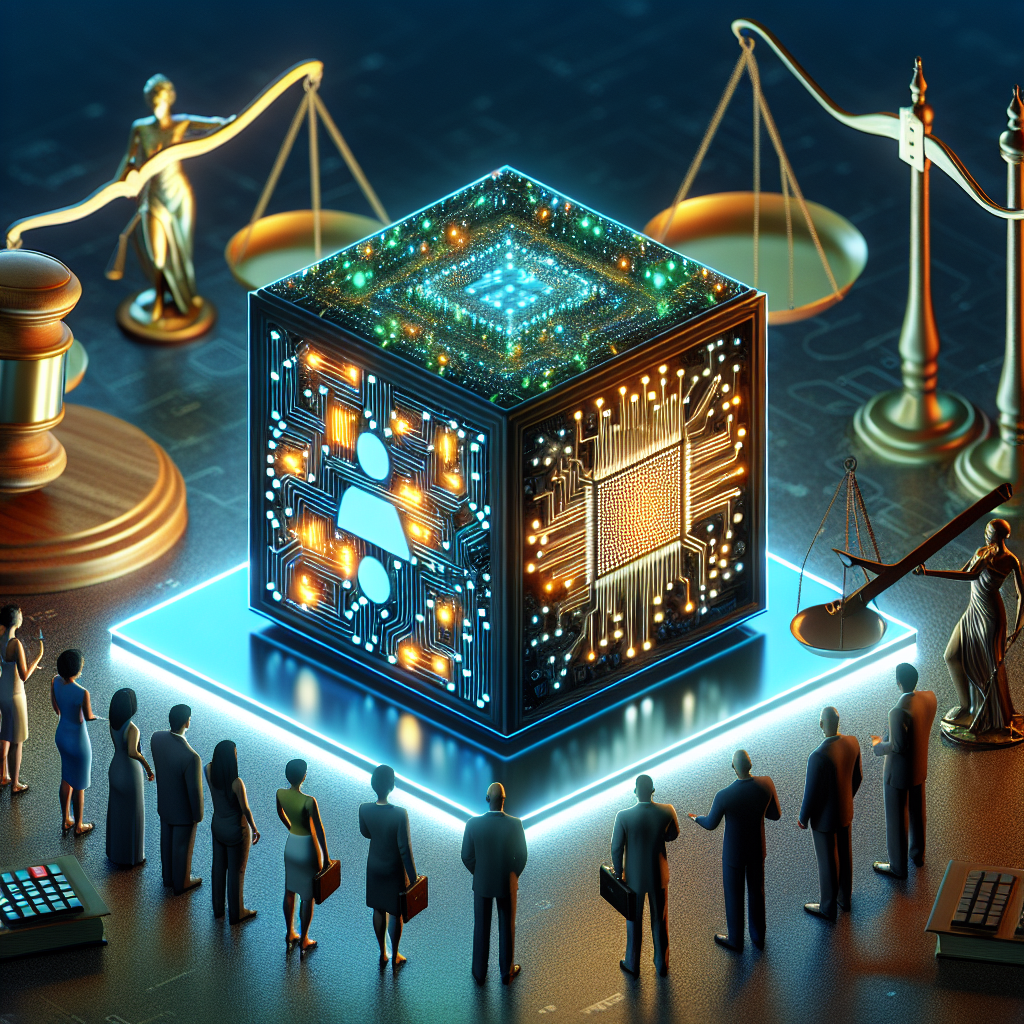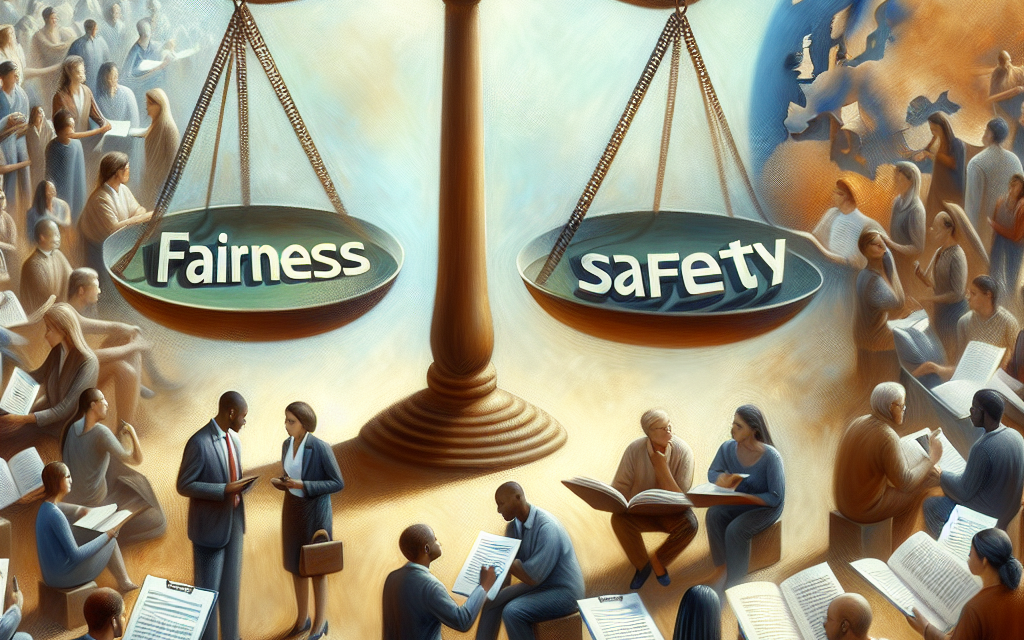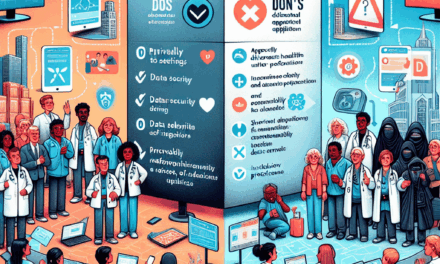Ensuring AI Safety and Fairness with Legal Frameworks and Human Oversight

Artificial Intelligence (AI) is rapidly transforming industries and societies, offering unprecedented opportunities for innovation and efficiency. However, the deployment of AI systems also raises significant concerns about safety, fairness, and ethical implications. As AI technologies become more integrated into daily life, ensuring their safe and fair use is paramount. This article explores the role of legal frameworks and human oversight in achieving these goals, providing a comprehensive analysis of the challenges and solutions in this critical area.
The Importance of AI Safety and Fairness
AI systems have the potential to revolutionize various sectors, from healthcare to finance, by automating complex tasks and providing insights that were previously unattainable. However, the power of AI also comes with risks, including biases in decision-making, lack of transparency, and potential harm to individuals and society. Ensuring AI safety and fairness is crucial to mitigate these risks and build trust in AI technologies.
Understanding AI Bias and Its Implications
AI bias occurs when an AI system produces results that are systematically prejudiced due to erroneous assumptions in the machine learning process. This can lead to unfair treatment of individuals based on race, gender, or other characteristics. For example, a study by MIT Media Lab found that facial recognition systems had higher error rates for darker-skinned individuals, highlighting the potential for AI to perpetuate existing social biases.
Bias in AI can have serious implications, particularly in high-stakes areas such as criminal justice, hiring, and lending. In the criminal justice system, biased AI algorithms can lead to unfair sentencing or parole decisions. In hiring, AI systems may inadvertently favor certain demographics over others, leading to discrimination. Addressing AI bias is essential to ensure that AI systems are fair and equitable.
The Role of Transparency in AI Systems
Transparency is a key component of AI safety and fairness. It involves making the decision-making processes of AI systems understandable and accessible to users and stakeholders. Transparent AI systems allow for better scrutiny and accountability, enabling users to understand how decisions are made and to identify potential biases or errors.
However, achieving transparency in AI is challenging due to the complexity of machine learning models, particularly deep learning algorithms. These models often operate as “black boxes,” making it difficult to interpret their decision-making processes. Efforts to improve transparency include developing explainable AI (XAI) techniques that provide insights into how AI systems arrive at their conclusions.
Ensuring Accountability in AI Deployment
Accountability is crucial for ensuring that AI systems are used responsibly and ethically. It involves establishing clear lines of responsibility for the outcomes of AI systems and ensuring that those responsible are held accountable for any negative impacts. This is particularly important in cases where AI systems are used in critical decision-making processes.
One approach to ensuring accountability is through the development of AI ethics guidelines and standards. These guidelines provide a framework for the responsible development and deployment of AI systems, outlining principles such as fairness, transparency, and accountability. Organizations can use these guidelines to assess their AI systems and ensure they align with ethical standards.
The Need for Robust Legal Frameworks
Legal frameworks play a crucial role in ensuring AI safety and fairness by providing a regulatory structure for the development and deployment of AI systems. These frameworks can help address issues such as bias, transparency, and accountability, providing a legal basis for enforcing ethical standards in AI.
Several countries and regions have begun developing legal frameworks for AI. For example, the European Union has proposed the Artificial Intelligence Act, which aims to regulate AI systems based on their risk level. The act includes provisions for ensuring transparency, accountability, and fairness in AI systems, providing a comprehensive legal framework for AI regulation.
The Role of Human Oversight in AI Systems
While legal frameworks are essential for ensuring AI safety and fairness, human oversight is equally important. Human oversight involves the involvement of human operators in the development, deployment, and monitoring of AI systems, ensuring that they are used responsibly and ethically.
Human oversight can take various forms, including human-in-the-loop (HITL) systems, where human operators are involved in the decision-making process, and human-on-the-loop (HOTL) systems, where human operators monitor AI systems and intervene when necessary. These approaches help ensure that AI systems are used in a way that aligns with ethical standards and societal values.
Legal Frameworks for AI Safety and Fairness
As AI technologies continue to evolve, the need for robust legal frameworks to ensure their safe and fair use becomes increasingly important. Legal frameworks provide a regulatory structure for the development and deployment of AI systems, addressing issues such as bias, transparency, and accountability. This section explores the role of legal frameworks in ensuring AI safety and fairness, highlighting key initiatives and challenges in this area.
The European Union’s Artificial Intelligence Act
The European Union (EU) has been at the forefront of developing legal frameworks for AI regulation. In April 2021, the European Commission proposed the Artificial Intelligence Act, a comprehensive legal framework aimed at regulating AI systems based on their risk level. The act categorizes AI systems into four risk levels: unacceptable risk, high risk, limited risk, and minimal risk, with corresponding regulatory requirements for each category.
The Artificial Intelligence Act includes provisions for ensuring transparency, accountability, and fairness in AI systems. For high-risk AI systems, the act requires rigorous testing and documentation to ensure compliance with safety and fairness standards. The act also includes measures to address bias in AI systems, requiring developers to implement measures to mitigate bias and ensure fairness.
The Artificial Intelligence Act represents a significant step forward in AI regulation, providing a comprehensive legal framework for ensuring AI safety and fairness. However, the act also faces challenges, including balancing innovation with regulation and addressing the diverse needs of different stakeholders.
The United States’ Approach to AI Regulation
In contrast to the EU’s comprehensive approach, the United States has taken a more decentralized approach to AI regulation. Rather than a single overarching legal framework, the U.S. has developed a patchwork of regulations and guidelines across different sectors and agencies.
For example, the National Institute of Standards and Technology (NIST) has developed a framework for AI risk management, providing guidelines for assessing and mitigating risks associated with AI systems. The Federal Trade Commission (FTC) has also issued guidelines for ensuring transparency and accountability in AI systems, emphasizing the importance of consumer protection.
While the U.S. approach allows for flexibility and innovation, it also presents challenges in ensuring consistency and coherence across different sectors and agencies. The lack of a unified legal framework can lead to gaps in regulation and enforcement, making it difficult to address issues such as bias and accountability comprehensively.
International Efforts to Develop AI Legal Frameworks
In addition to regional efforts, there are also international initiatives aimed at developing legal frameworks for AI regulation. The Organisation for Economic Co-operation and Development (OECD) has developed the OECD AI Principles, a set of guidelines for the responsible development and deployment of AI systems. These principles emphasize the importance of transparency, accountability, and fairness in AI systems, providing a framework for international cooperation on AI regulation.
The United Nations has also been involved in efforts to develop international legal frameworks for AI regulation. The UN’s International Telecommunication Union (ITU) has established a focus group on AI for autonomous and assisted driving, aimed at developing standards and guidelines for the safe and fair use of AI in transportation.
International efforts to develop legal frameworks for AI regulation face challenges, including differences in regulatory approaches and priorities among countries. However, these efforts are crucial for ensuring a consistent and coordinated approach to AI regulation globally.
Challenges in Developing Legal Frameworks for AI
Developing legal frameworks for AI regulation presents several challenges, including balancing innovation with regulation, addressing the diverse needs of different stakeholders, and ensuring consistency and coherence across different sectors and regions.
One of the key challenges is balancing innovation with regulation. While legal frameworks are essential for ensuring AI safety and fairness, overly restrictive regulations can stifle innovation and hinder the development of new AI technologies. Striking the right balance between regulation and innovation is crucial for fostering a thriving AI ecosystem.
Another challenge is addressing the diverse needs of different stakeholders. AI systems are used in a wide range of sectors, each with its own unique requirements and challenges. Developing legal frameworks that address the needs of different sectors and stakeholders is essential for ensuring the effective regulation of AI systems.
The Future of Legal Frameworks for AI Regulation
The development of legal frameworks for AI regulation is an ongoing process, with new challenges and opportunities emerging as AI technologies continue to evolve. As legal frameworks continue to develop, it is essential to ensure that they are flexible and adaptable to changing technological and societal needs.
One potential future direction for legal frameworks is the development of sector-specific regulations that address the unique challenges and requirements of different sectors. This approach allows for more targeted and effective regulation, ensuring that AI systems are used safely and fairly in each sector.
Another potential future direction is the development of international legal frameworks that provide a consistent and coordinated approach to AI regulation globally. International cooperation is crucial for addressing the global nature of AI technologies and ensuring that AI systems are used responsibly and ethically worldwide.
Human Oversight in AI Systems
While legal frameworks provide a regulatory structure for ensuring AI safety and fairness, human oversight is equally important. Human oversight involves the involvement of human operators in the development, deployment, and monitoring of AI systems, ensuring that they are used responsibly and ethically. This section explores the role of human oversight in AI systems, highlighting key approaches and challenges in this area.
Human-in-the-Loop (HITL) Systems
Human-in-the-loop (HITL) systems involve the active participation of human operators in the decision-making process of AI systems. In HITL systems, human operators are responsible for reviewing and approving decisions made by AI systems, ensuring that they align with ethical standards and societal values.
HITL systems are particularly important in high-stakes areas such as healthcare and criminal justice, where the consequences of AI decisions can have significant impacts on individuals and society. By involving human operators in the decision-making process, HITL systems help ensure that AI systems are used responsibly and ethically.
However, HITL systems also present challenges, including the potential for human error and bias. Human operators may not always have the expertise or information needed to make informed decisions, leading to errors or biases in the decision-making process. Ensuring that human operators are adequately trained and informed is crucial for the effective implementation of HITL systems.
Human-on-the-Loop (HOTL) Systems
Human-on-the-loop (HOTL) systems involve the monitoring of AI systems by human operators, who intervene when necessary to ensure that AI systems are used responsibly and ethically. In HOTL systems, human operators are responsible for overseeing the operation of AI systems and taking corrective action when needed.
HOTL systems are particularly useful in areas where AI systems operate autonomously, such as autonomous vehicles and drones. By providing human oversight, HOTL systems help ensure that AI systems operate safely and ethically, even in complex and dynamic environments.
However, HOTL systems also present challenges, including the potential for human operators to become overwhelmed by the volume of data and decisions generated by AI systems. Ensuring that human operators have the tools and support needed to effectively monitor AI systems is crucial for the successful implementation of HOTL systems.
The Role of Human Oversight in Addressing AI Bias
Human oversight plays a crucial role in addressing bias in AI systems. By involving human operators in the development, deployment, and monitoring of AI systems, human oversight helps ensure that AI systems are used fairly and equitably.
One approach to addressing bias through human oversight is the use of diverse teams in the development and deployment of AI systems. By involving individuals from diverse backgrounds and perspectives, organizations can help ensure that AI systems are designed and used in a way that is fair and equitable.
Another approach is the use of bias audits, where human operators review and assess AI systems for potential biases. Bias audits help identify and address biases in AI systems, ensuring that they are used fairly and equitably.
Challenges in Implementing Human Oversight
Implementing human oversight in AI systems presents several challenges, including the potential for human error and bias, the need for adequate training and support for human operators, and the complexity of monitoring and overseeing AI systems.
One of the key challenges is the potential for human error and bias. Human operators may not always have the expertise or information needed to make informed decisions, leading to errors or biases in the decision-making process. Ensuring that human operators are adequately trained and informed is crucial for the effective implementation of human oversight.
Another challenge is the complexity of monitoring and overseeing AI systems. AI systems can generate large volumes of data and decisions, making it difficult for human operators to effectively monitor and oversee their operation. Providing human operators with the tools and support needed to effectively monitor AI systems is crucial for the successful implementation of human oversight.
The Future of Human Oversight in AI Systems
The role of human oversight in AI systems is likely to continue to evolve as AI technologies become more advanced and integrated into daily life. As AI systems become more autonomous and complex, the need for effective human oversight will become increasingly important.
One potential future direction for human oversight is the development of advanced monitoring and intervention tools that provide human operators with the information and support needed to effectively oversee AI systems. These tools could include real-time monitoring dashboards, automated alerts, and decision support systems that help human operators make informed decisions.
Another potential future direction is the development of collaborative AI systems that work alongside human operators, providing support and assistance in decision-making processes. Collaborative AI systems could help enhance human oversight by providing human operators with additional insights and perspectives, ensuring that AI systems are used responsibly and ethically.
Case Studies: Legal Frameworks and Human Oversight in Action
To better understand the practical application of legal frameworks and human oversight in ensuring AI safety and fairness, it is helpful to examine real-world case studies. These case studies provide valuable insights into the challenges and successes of implementing legal frameworks and human oversight in AI systems.
Case Study: The Use of AI in Healthcare
AI technologies have the potential to revolutionize healthcare by improving diagnosis, treatment, and patient outcomes. However, the use of AI in healthcare also raises significant concerns about safety, fairness, and ethical implications. Legal frameworks and human oversight play a crucial role in addressing these concerns.
One example of the use of AI in healthcare is the development of AI-powered diagnostic tools. These tools use machine learning algorithms to analyze medical images and provide diagnostic recommendations. To ensure the safety and fairness of these tools, legal frameworks require rigorous testing and validation to ensure their accuracy and reliability.
Human oversight is also essential in the use of AI-powered diagnostic tools. Human operators, such as radiologists and pathologists, are responsible for reviewing and validating the recommendations made by AI systems, ensuring that they align with clinical standards and ethical guidelines.
Case Study: The Use of AI in Criminal Justice
The use of AI in criminal justice has the potential to improve efficiency and fairness in areas such as sentencing and parole decisions. However, the use of AI in criminal justice also raises significant concerns about bias and accountability.
One example of the use of AI in criminal justice is the development of risk assessment tools that use machine learning algorithms to predict the likelihood of reoffending. To ensure the fairness and accountability of these tools, legal frameworks require transparency and documentation of the algorithms used, as well as measures to address potential biases.
Human oversight is also crucial in the use of AI-powered risk assessment tools. Human operators, such as judges and parole officers, are responsible for reviewing and validating the recommendations made by AI systems, ensuring that they align with legal standards and ethical guidelines.
Case Study: The Use of AI in Autonomous Vehicles
Autonomous vehicles have the potential to revolutionize transportation by improving safety and efficiency. However, the use of AI in autonomous vehicles also raises significant concerns about safety, accountability, and ethical implications.
Legal frameworks play a crucial role in ensuring the safety and accountability of autonomous vehicles. These frameworks require rigorous testing and validation of autonomous vehicle technologies, as well as measures to ensure transparency and accountability in their operation.
Human oversight is also essential in the use of autonomous vehicles. Human operators, such as safety drivers and remote operators, are responsible for monitoring and overseeing the operation of autonomous vehicles, ensuring that they operate safely and ethically.
Case Study: The Use of AI in Hiring
AI technologies have the potential to improve efficiency and fairness in hiring processes by automating tasks such as resume screening and candidate assessment. However, the use of AI in hiring also raises significant concerns about bias and discrimination.
Legal frameworks play a crucial role in ensuring the fairness and accountability of AI-powered hiring tools. These frameworks require transparency and documentation of the algorithms used, as well as measures to address potential biases and ensure compliance with anti-discrimination laws.
Human oversight is also crucial in the use of AI-powered hiring tools. Human operators, such as hiring managers and recruiters, are responsible for reviewing and validating the recommendations made by AI systems, ensuring that they align with ethical standards and legal requirements.
Case Study: The Use of AI in Finance
AI technologies have the potential to improve efficiency and accuracy in financial services by automating tasks such as fraud detection and credit scoring. However, the use of AI in finance also raises significant concerns about bias, transparency, and accountability.
Legal frameworks play a crucial role in ensuring the fairness and accountability of AI-powered financial tools. These frameworks require transparency and documentation of the algorithms used, as well as measures to address potential biases and ensure compliance with financial regulations.
Human oversight is also essential in the use of AI-powered financial tools. Human operators, such as financial analysts and compliance officers, are responsible for reviewing and validating the recommendations made by AI systems, ensuring that they align with ethical standards and regulatory requirements.
Conclusion: The Path Forward for AI Safety and Fairness
Ensuring AI safety and fairness is a complex and multifaceted challenge that requires a coordinated effort from legal frameworks, human oversight, and technological innovation. Legal frameworks provide a regulatory structure for addressing issues such as bias, transparency, and accountability, while human oversight ensures that AI systems are used responsibly and ethically.
As AI technologies continue to evolve, it is essential to ensure that legal frameworks and human oversight are flexible and adaptable to changing technological and societal needs. This includes developing sector-specific regulations that address the unique challenges and requirements of different sectors, as well as international cooperation to ensure a consistent and coordinated approach to AI regulation globally.
Ultimately, the path forward for AI safety and fairness requires a collaborative effort from governments, industry, academia, and civil society. By working together, we can ensure that AI technologies are used in a way that benefits society while minimizing risks and ensuring fairness and accountability.





